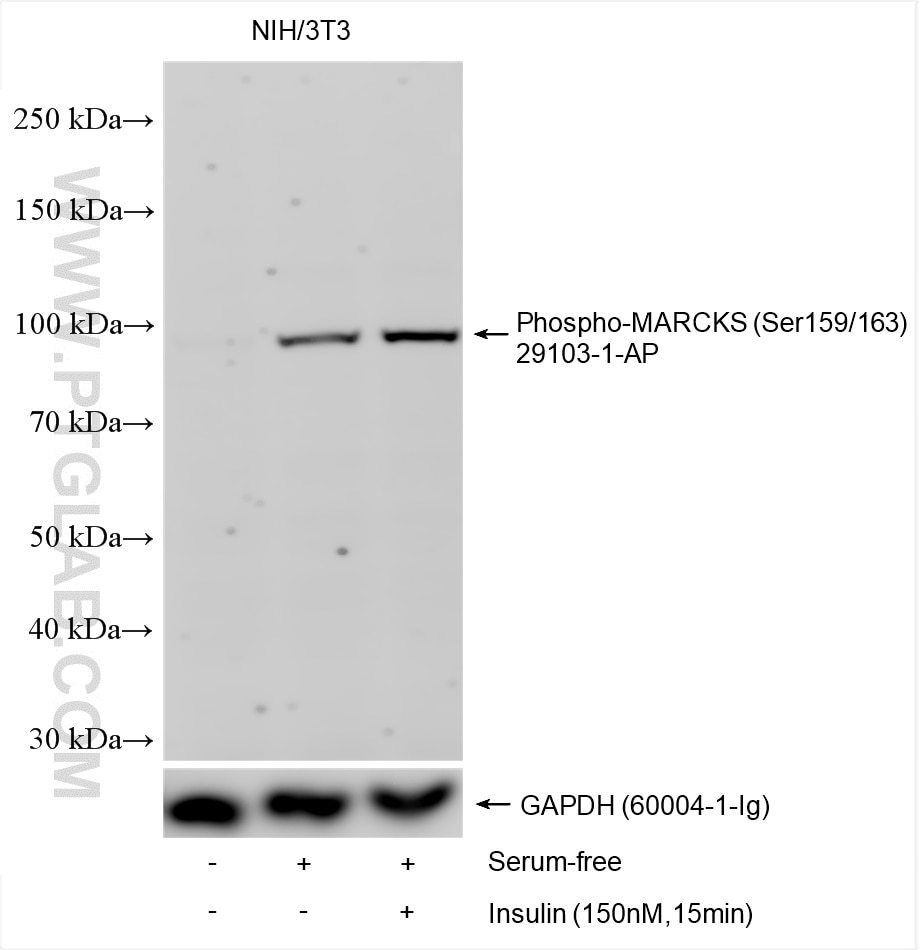Phospho-MARCKS (Ser159/163) Polyklonaler Antikörper
Phospho-MARCKS (Ser159/163) Polyklonal Antikörper für WB, ELISA
Wirt / Isotyp
Kaninchen / IgG
Getestete Reaktivität
human, Maus
Anwendung
WB, ELISA
Konjugation
Unkonjugiert
Kat-Nr. : 29103-1-AP
Synonyme
Galerie der Validierungsdaten
Geprüfte Anwendungen
| Erfolgreiche Detektion in WB | Serum-free treated NIH/3T3 cells |
Empfohlene Verdünnung
| Anwendung | Verdünnung |
|---|---|
| Western Blot (WB) | WB : 1:1000-1:6000 |
| It is recommended that this reagent should be titrated in each testing system to obtain optimal results. | |
| Sample-dependent, check data in validation data gallery | |
Veröffentlichte Anwendungen
| WB | See 1 publications below |
Produktinformation
29103-1-AP bindet in WB, ELISA Phospho-MARCKS (Ser159/163) und zeigt Reaktivität mit human, Maus
| Getestete Reaktivität | human, Maus |
| In Publikationen genannte Reaktivität | human |
| Wirt / Isotyp | Kaninchen / IgG |
| Klonalität | Polyklonal |
| Typ | Antikörper |
| Immunogen | Peptid |
| Vollständiger Name | myristoylated alanine-rich protein kinase C substrate |
| Berechnetes Molekulargewicht | 32 kDa |
| Beobachtetes Molekulargewicht | 80 kDa |
| GenBank-Zugangsnummer | BC089040 |
| Gene symbol | MARCKS |
| Gene ID (NCBI) | 4082 |
| Konjugation | Unkonjugiert |
| Form | Liquid |
| Reinigungsmethode | Antigen-Affinitätsreinigung |
| Lagerungspuffer | PBS mit 0.02% Natriumazid und 50% Glycerin pH 7.3. |
| Lagerungsbedingungen | Bei -20°C lagern. Nach dem Versand ein Jahr lang stabil Aliquotieren ist bei -20oC Lagerung nicht notwendig. 20ul Größen enthalten 0,1% BSA. |
Hintergrundinformationen
The Myristoylated Alanine Rich C-Kinase Substrate (MARCKS) is a ubiquitous, highly conserved protein among vertebrates, which is essential for postnatal survival, and has been widely studied for its functions in the brain and nervous system. Being highly expressed in nervous tissue, particularly during early development but persisting in the adult, it plays numerous roles related to brain growth, neuronal migration, neurite outgrowth, neurotransmitter release, and synaptic plasticity. Protein kinase C (PKC) phosphorylates MARCKS, which converts MARCKS from a membrane-bound protein to a cytoplasmic protein. The phosphorylation site of MARCKS protein is called the effector domain (ED). Its structure is highly conserved. It can be combined with cell membrane, PKC, calcium/calmodulin-dependent kineses (CaMK) and F-actin. Studies have shown that increased membrane-bound, non-phosphorylated MARCKS might be conducive to the stabilization of synaptic morphology. Phosphorylated MARCKS protein (P-MARCKS) can regulate the stability of actin network and alter the synaptic structure. (PMID: 30655546, PMID: 30155805)
Protokolle
| Produktspezifische Protokolle | |
|---|---|
| WB protocol for Phospho-MARCKS (Ser159/163) antibody 29103-1-AP | Protokoll herunterladen |
| Standard-Protokolle | |
|---|---|
| Klicken Sie hier, um unsere Standardprotokolle anzuzeigen |
Publikationen
| Species | Application | Title |
|---|---|---|
World J Gastrointest Oncol LINC01268 promotes epithelial-mesenchymal transition, invasion and metastasis of gastric cancer via the PI3K/Akt signaling pathway and targeting MARCKS |


